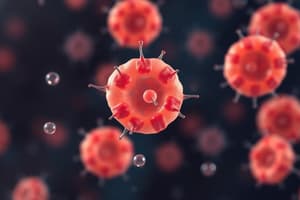Podcast
Questions and Answers
James Till's research, alongside Ernest McCulloch, primarily centered on which biological component?
James Till's research, alongside Ernest McCulloch, primarily centered on which biological component?
- Undifferentiated cells in bone marrow (correct)
- Muscle cells responsible for skeletal movement
- Nerve cells within the central nervous system
- Epithelial cells forming the outer layer of skin
What was the primary focus of the seminal 1961 paper co-authored by James Till and Ernest McCulloch?
What was the primary focus of the seminal 1961 paper co-authored by James Till and Ernest McCulloch?
- The development of novel cancer treatments using radiation
- The role of the internet in improving patient quality of life post-cancer treatment
- The ethical implications of radiation therapy on cancer patients
- The sensitivity of murine bone marrow cells to ionizing radiation (correct)
In which specific location did Till and McCulloch discover the presence of unspecialized adult stem cells?
In which specific location did Till and McCulloch discover the presence of unspecialized adult stem cells?
- The outer periosteum layer of long bones
- The central, dense cortical bone tissue
- The inner marrow of bones (correct)
- The cartilaginous epiphyseal plates of bones
Which sequence accurately represents the chronological order of James Till's affiliations and achievements?
Which sequence accurately represents the chronological order of James Till's affiliations and achievements?
Prior to his significant contributions to biophysics, in what field did James Till initially pursue his undergraduate studies?
Prior to his significant contributions to biophysics, in what field did James Till initially pursue his undergraduate studies?
The Albert Lasker Award for Basic Medical Research, jointly awarded to Till and McCulloch, recognized their contributions to which area?
The Albert Lasker Award for Basic Medical Research, jointly awarded to Till and McCulloch, recognized their contributions to which area?
Beyond stem cell research, James Till expanded his research interests to include which of the following areas?
Beyond stem cell research, James Till expanded his research interests to include which of the following areas?
The 1961 paper by Till and McCulloch is considered 'seminal' primarily because it:
The 1961 paper by Till and McCulloch is considered 'seminal' primarily because it:
What was the primary motivation behind James Till's decision to return to Canada and accept a position at the University of Toronto in 1957?
What was the primary motivation behind James Till's decision to return to Canada and accept a position at the University of Toronto in 1957?
Flashcards
James Till
James Till
A physicist known for research in cancer treatment and stem cells.
Stem Cells
Stem Cells
Unspecialized cells in bone marrow that can develop into any type of blood cell.
Radiation Sensitivity
Radiation Sensitivity
The response of cells to ionizing radiation, significant in cancer treatment.
Albert Lasker Award
Albert Lasker Award
Signup and view all the flashcards
Royal Society of Canada
Royal Society of Canada
Signup and view all the flashcards
University of Toronto
University of Toronto
Signup and view all the flashcards
Biophysics PhD
Biophysics PhD
Signup and view all the flashcards
Ontario Cancer Institute
Ontario Cancer Institute
Signup and view all the flashcards
Cancer Treatment Research
Cancer Treatment Research
Signup and view all the flashcards
Study Notes
James Till: Scientist and Discoverer of Stem Cells
- Born in 1931 in rural Canada
- Earned a PhD in biophysics from Yale University in 1957
- Worked at the University of Toronto, and the Ontario Cancer Institute
- Collaborated with Ernest McCulloch on stem cell research
- Discovered the existence and workings of stem cells in mouse bone marrow
- Published research in 1961 on the radiation sensitivity of mouse bone marrow cells
- Became a Fellow of the Royal Society of Canada in 1969
- Awarded the Albert Lasker Award for Basic Medical Research in 2005, jointly with Ernest McCulloch
Key Contributions
- Made significant contributions to understanding stem cells
- Continued research in cancer treatment, research ethics, and patient advocacy
- His work expanded to include the role of the internet and patient support
Studying That Suits You
Use AI to generate personalized quizzes and flashcards to suit your learning preferences.





